A Fan Conversation: How CABIN IN THE WOODS Kills Kids & Starts The Apocalypse
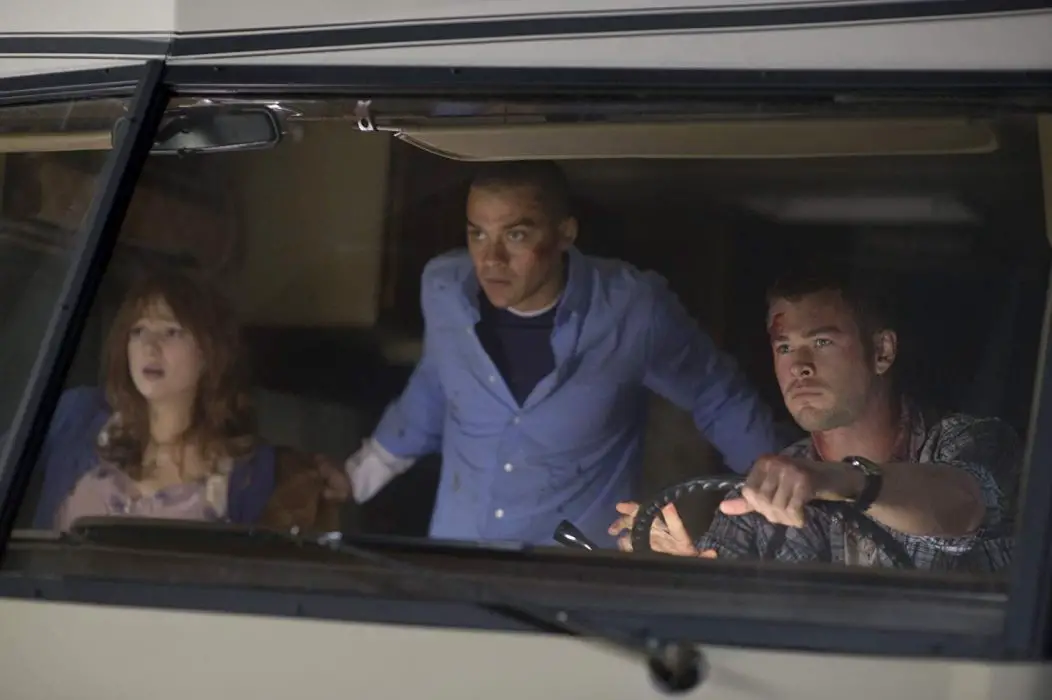
Film critic, Ithaca College graduate, University of St Andrews masters…
Karen Pinilla loves Cabin in the Woods. It’s her favorite horror movie ever. And she breathes horror movies, so that endorsement really counts for something.
Karen and I interned together in Los Angeles for Blumhouse Productions when we were still students in film school. As we worked on horror projects for the company, many of our own conversations turned to horror as well: which movies we love, which ones we detest, what scares us, what keeps us up at night, eyes wide open, lying there in the dark. Horror is a year-round obsession for her in a way it isn’t for so many other horror fans. She’s the closest to a horror movie expert I have the privilege to know.
She’s since moved to Los Angeles but managed to find the time to chat with me over the phone about Cabin in the Woods. The film, written by Drew Goddard and Joss Whedon and directed by Goddard, is a treasure trove of horror references, great one-liners, and essay-ready metatextual ideas about what it means when we watch scary movies. It’s also Karen’s favorite, so from one film student to another, I hoped we could break down what we love so much about Cabin in the Woods.
The following interview is, I assured Karen, heavily edited and condensed — she and I could go on about Cabin in the Woods all day.
Beware — there are full spoilers ahead for Cabin in the Woods, a movie that you should definitely go in blind for.
Clement: I have my coffee, so I’m ready to go.
Karen: My tea is brewing, but it’s fine. We don’t have to wait for it.
Clement: So Karen — how many times have you seen Cabin in the Woods?
Karen: [laughs] At least 12.
Clement: Oh my God. This is my fourth time only.
Stoner Dialogue
Clement: I wasn’t really looking forward to rewatching Cabin in the Woods because the sort of more Joss Whedon-influenced elements — some of the quippier conversations and cringy lines — jump out at me the more I think about it. Especially with Fran Kranz’s stoner character, Marty. I don’t think that he’s written very well, but I think the performance is so great that it compensates. He gets this eccentric “stoner” dialogue, like the writers have never been stoned in their lives and this is what they think stoners sound like.
Karen: I feel like that was purposeful. I feel like they wanted him to be so blatantly high. He’s the only one out of all the characters who starts off as the archetype. And then he becomes a character, you know? I read an interview with Drew Goddard where explained that, and he said that all of them become what the “down-under” people, the— what is their name? The people underground….
Clement: The Ancient Ones? Or the office people who work for them?
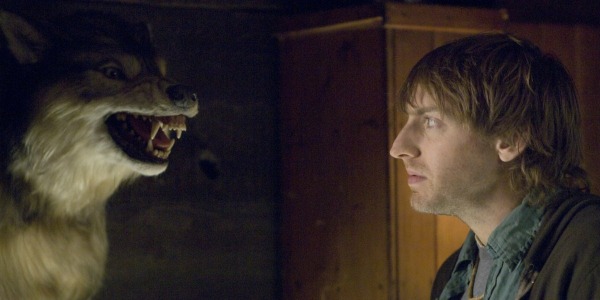
Karen: Yeah, them. The office people. They want the kids to become these archetypes so they can be sacrificed, but with Marty, he was already an archetype, so it’s reversed. Because with the other characters, they’re forced to change into the archetypes. Chris Hemsworth becomes the stupid he-man, but at the beginning of the film, he’s this very academic guy talking about these textbooks he liked. But then they get to the cabin and did very headass things, you know?
So with Fran Kranz’s character, it’s purposeful that he acts so over-the-top. No people I know who smoke act like that, but I feel like it’s what we all know as the archetype.
Clement: I think it’s interesting that the one person who’s not a created archetype is the person who winds up screwing everything over. He has the most power in the movie, and he’s the one rogue element when really he should just slot in from the beginning. And he winds up dismantling the entire system.
Karen: In the Goddard interview, he said he feels like society in general tries to make you fit into certain categories. We put people into these categories just to destroy them later for it. And Marty already kind of was “the fool,” the funny stoner trope — but they didn’t push him to become something he wasn’t.
So Who’s The Main Character?
Clement: Marty is basically the main character of the film, but Cabin in the Woods does a very strange thing — in order to satirize the genre and become this huge, all-encompassing tribute to horror films, it has to first become the thing that it’s going to later satirize. It’s very smart about this, and I pick up on it a little more every time I see the movie. So the first 40–45 minutes are like a straight horror film, basically, with only the cutaways to the office people being a departure from that.
But it’s not even really very different formulaically from other horror films because we still see the office people as the villains. Then, because it’s trying to be that classic kind of horror movie, naturally Dana [played by Kristen Connolly] comes out as the lead, even though compared to Marty, she doesn’t have that much to do. Really, the only thing she does in the entire movie is just survive!
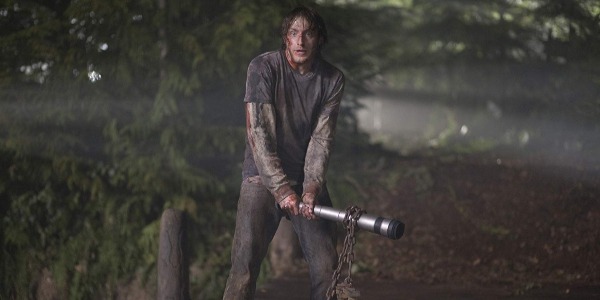
Karen: And that final choice in the end. Technically she did make the final decision to end the world when she could’ve killed Marty instead. She made literally one of the most important decisions, but it wasn’t until the very, very end.
Clement: In that last scene, too, I was waiting for Sigourney Weaver to say some summative line that never comes. When she’s going through all these archetypes, she says something to the effect of “They’re all being punished for being young.” But she never goes into detail on that. So to her, there’s no deeper reason that it’s young people who are being punished — it’s treated as though that’s how it’s always been.
Karen: I mean, that’s kind of how it is in the real world, too. The young are the ones who get punished, berated, torn apart, blamed.
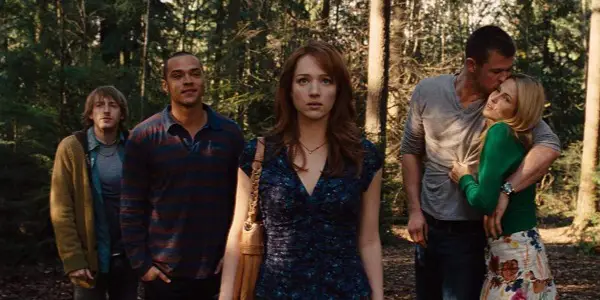
Clement: Especially when we live in a sociological structure that basically decides who you’re going to be by the time you’re in your twenties.
Karen: Yeah! Exactly. And you notice it just with the simple question of “What are you doing after you graduate?” or like, “What are you doing with your life?”
Clement: Or “Where are you going to college?”
Karen: Yeah, when you’re 12, nobody gives a shit. Nobody’s asking you that. Nobody’s like, “What are your plans?” But once you hit adulthood, people ask themselves, “How can I categorize you in my mind? Are you going to be unemployed? Are you going to work at a crummy day job or a marketing company?”
Sometimes I meet with my peers and I say, “Yeah, I moved to L.A. without having a job.” And they say, “Oh, that’s kind of badass,” or they say, “That’s cool and risky.” But then you tell people’s parents that, and they’re like, “Oh….” You know?
Not to say that youth is innocent, but it is the age when people want to categorize you. You have to belong somewhere in their mind, or else you’re just like a loose cannon.
Clement: So basically Cabin in the Woods is the horror-satire version of the Seven Up! series.
Karen: Right! And getting back to Dana, I think that usually in horror movies, who’s the main character? A girl. It’s easier for audiences to have empathy for a pure, innocent girl with her whole life ahead of her. So I think that’s why Drew Goddard made her the main character, you know?
Clement: Yeah, and also, as a filmmaker, he’s kind of wearing two hats. He’s wearing the hat of the director who’s trying to question the tropes of horror movies. But he’s also playing the role of the guys downstairs when he’s making the film. As though he’s the Bradley Whitford character orchestrating the show, pulling the strings.
He knows the audience isn’t going to sympathize with the stoner character from the outset because they think this guy’s a bum. They’re more likely to see him as an irritating character who probably deserves to die more than the virgin does. And so the whole movie then, Dana and Marty are rebelling against not just the people downstairs, but they’re also rebelling against horror tropes and their tendency to, as you said, put people into categories.
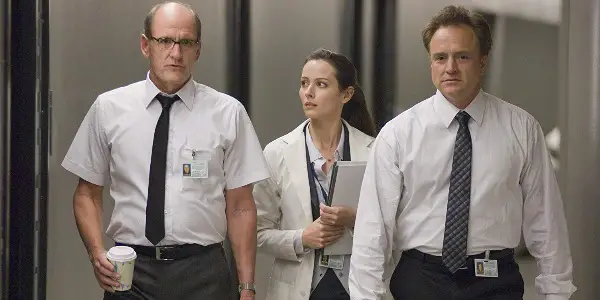
Karen: Yeah, exactly. That’s the perfect way to put it.
Apocalypse How?
Karen: I’ve never had no stress writing a paper, but I wrote a paper about Cabin in the Woods for my 12-page last assignment of my senior year, and I did not stress at all. Basically, I took the last five minutes of the movie and used that to consider it an apocalyptic film. For example, Sigourney Weaver serves as what’s called “the rudder,” the director.
Groups that are apocalyptic, they need a rudder. They need some kind of ancient text, and they need the threat of some kind of apocalypse or big event.
There’s something called “anomie” — and it basically means fear or confusion based on apocalyptic belief. Not knowing, the fear of not knowing, of not knowing what comes next. And I think that’s a huge part of the film.
Clement: Because the people downstairs — the office workers — are doing what they’re doing out of fear of the end of the world. Even though they don’t know what it’ll look like or how it’ll happen. And then we see their relief when they think they finally did it. It’s not relief that they’ve killed the kids. It’s relief that they’re not all going to die in a horrible, fiery apocalypse.
Karen: Something that usually happens in apocalyptic stories is something called “lifting the veil,” when apocalyptic belief is accepted. When the truth about the world that was previously unknown becomes known. They can see how the world is supposed to be, that kind of thing. In Christianity, that’s like the thought that “if I die, I go to heaven.”
And I think Cabin in the Woods visually personifies this “lifting the veil” idea quite literally with the upstairs-and-downstairs dynamic. Because upstairs, at the cabin, are the people that don’t know what the f*ck’s going on. They just think someone’s trying to kill them. They have no idea what’s going on below, the bigger picture.
But once they literally go downstairs, suddenly that veil is lifted. First they see the elevators and the facility and start to figure out what’s going on, and then the director explains everything. “They’re just waiting for their chance to rise again if we don’t do a sacrifice,” that kind of thing.
I don’t think Joss Whedon and Drew Goddard intended for this to be an apocalyptic film or to be analyzed as one, but there are so many aspects of it that are apocalyptic.
Clement: It’s also a criticism of the subgenre, too. Because it ties the apocalyptic story directly with the desire, as you said, to torture youth and to punish them. And that kind of takes on a more metatextual bent when you look at what we’re going through right now. We have our own apocalypse coming in the future with climate change, and that’s the prime example of punishing the younger generation.
And only now, with worldwide protests and Greta Thunberg, we’re seeing the rebellion against that. And you can see in the film that the cabin-dwellers kind of represent this millennial generation, and the people downstairs sort of stand in for Baby Boomers. Aged adult figures who tell and prompt the younger people to do what it takes to save the world. And it’s an easy allegory, too. The youngest person in the facility is probably the intern, and he looks like he’s 32. He’s got these thick sideburns and everything. It’s like oh my god, he’s unpaid? How does he live?!
Karen: With that idea that the film’s also criticizing apocalyptic groups — many groups have apocalyptic beliefs that are pre-millenium. So the people who convert to the group, to the belief that they’re following, think they’ll survive the apocalypse and will get to experience a peaceful millennium. It’s supposed to be a calm new world where everything’s all right and all the pain and suffering is being taken away, and Cabin in the Woods, I think, turns that idea on its head.
In the end, they don’t get to experience that. Literally all of them die, and then the Ancient Ones rise. The ending, where Sigourney Weaver dies and falls into the lava, says, like, “Even if you believed in this, you don’t get to live. You’re dying like everybody else.”
That Tunnel Should’ve Blown Hours Ago!
Clement: There’s a narrative shift that happens at the scene where they have to blow the tunnel because up until that point, the people in the facility are treated as the comic relief, for one, but also they’re the villains, and we’re supposed to be rooting against them and for the kids to survive.
But in the tunnel blowing scene, it’s the first time the movie asks us to root for the antagonists and against the kids. There’s like quick cuts. There’s suddenly exciting music. Everybody’s shouting to get out of the way as Richard Jenkins is powering through the hallway and trying to make the tunnel blow in time.
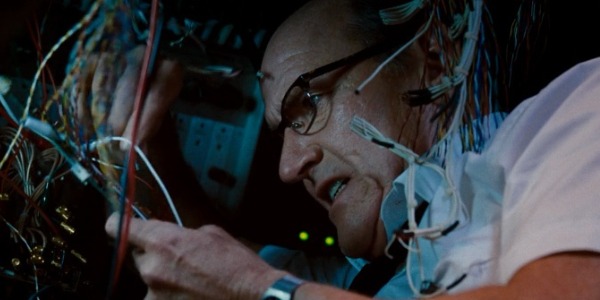
Karen: We’re conflicted who we’re rooting for. Even the beginning is literally just the two guys, Richard Jenkins and Bradley Whitford just being normal dudes talking about cabinets and their wives or something like that. And they’re funny! That scene where they’re placing bets on the monsters is hilarious. They’re likable guys! Bradley Whitford is just a likable-looking human!
Clement: And Bradley Whitford, I feel I should mention, has slowly been working his way through the best modern horror movies. Between this and Get Out. Guy’s got a good track record.
Karen: Right?! And during that tunnel scene, Richard Jenkins was sprinting, and I thought, holy shit, he’s gotta get there in time! But then I was like, wait a second. You’re supposed to be rooting for these other people. And that’s when the film says, like, “Look what role you play in this. Look how easily we got you on the bad guys’ side.” As if you’re an accomplice in this, like you wanted this to happen so the kids could keep getting killed.
Clement: Right, like with the sex scene for example, in the woods. When the movie cuts to the office full of sad-sack middle-aged dudes watching the big monitor, it’s basically saying, like, “This is you. This is the audience watching this thing, so you in the dark theater, this is what you look like!”
And the security guard [Brian White] questions why they want Jules [Anna Hutchison] to take her shirt off for the sex scene, and Bradley Whitford says, “We’re not the only ones watching.” And in the world of the film, he means the Ancient Ones and the Director. But on a different level, he’s talking about the audience.
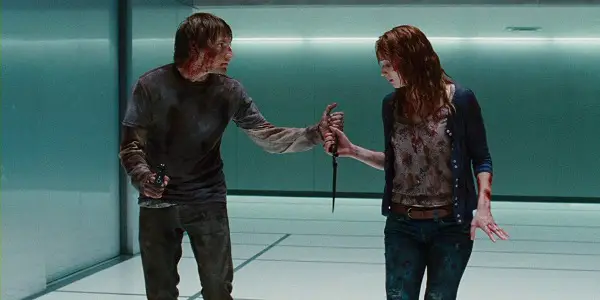
Shoot The Stoner
Karen: So if you were in Dana’s shoes at the end, and if you had the gun, would you… like, would you have killed your stoner friend?
Clement: Oh, definitely.
Karen: Do you mind if I answer it?
Clement: Oh, okay, hold on, Karen, let me pitch you the question. Karen — would you kill your stoner friend?
Karen: You know, when I first saw it, I felt like, “Hell yeah I’d kill him.” I feel like I’ve always had the mentality of like, the ends justify the means — I mean, obviously, within reason.
If you gotta kill one person to save the whole world, then they gotta die, you know? And then I got to thinking, like, even if I get to live, what’s going to change? I’m going back to the same society, and they’re gonna do this every year, and what’s changing?
Clement: Right. It’s a choice at the end whether or not to rebuild the system or just dismantle it entirely.
Karen: Right, and it’s like the extreme dismantling. But also it’s like, the old gods that are rising are evil, and they’re gonna literally torture and kill every living being. And I don’t want the people I love to die like that. Ugh. So sorry, stoner friend, you’re gonna have to go. I think I’d do it too.
Clement: Well, if you do kill him, it’s not like you’re gonna live for much longer anyway. The entire facility’s overrun with horrible nightmare creatures.
Karen: Oh, that’s facts!
Clement: So you’re screwed either way.
Karen: Yeah, and I have that huge-ass werewolf bite, remember?
Clement: Yeah!
Karen: So I really am risking it all just to save everybody. Yeah, so I’d still do it. I’d kill him. A hundred percent.
Clement: Yay! Murder!
Karen: Yeah, that’s all. My favorite horror film, and I’m glad I got to share these thoughts with you.
Karen and I are genuinely curious whether or not you would kill Marty at the end of the film, so please leave a comment below. Let us know!
Does content like this matter to you?
Become a Member and support film journalism. Unlock access to all of Film Inquiry`s great articles. Join a community of like-minded readers who are passionate about cinema - get access to our private members Network, give back to independent filmmakers, and more.
Film critic, Ithaca College graduate, University of St Andrews masters student, head of the "Paddington 2" fan club.













